July 24, 2000 – BP unveils New Green and Yellow Logo –
BP the official name of a group of companies that included Amoco, ARCO and Castrol, unveiled a new corporate identity brand, replacing the “Green Shield” logo with a green and yellow sunflower pattern.

The company also introduced a new corporate slogan: “Beyond Petroleum.” When BP — then British Petroleum — merged with Amoco in 1998, the company’s name briefly changed to BP Amoco before all stations converted to the BP brand.
July 25, 1543 – Oil reported in New World
The first documented report of oil in the New World resulted when a storm forced Spanish explorer Don Luis de Moscoso to land two of his brigantines at the mouth of the Sabine River. He had succeeded expedition leader Hernando de Soto and built seven of the small vessels to sail down the newly discovered Mississippi River and westward along the Gulf Coast.
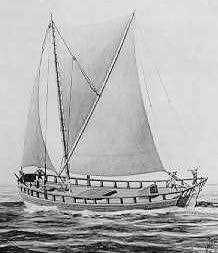
Spanish explorers used brigantines to travel along the Gulf Coast in 1543.
According an account of the expedition, Indians knew of the future Texas’ natural seeps. “There was found a skumme, which they call Copee, which the Sea casteth up, and it is like Pitch, wherewith in some places, where Pitch is wanting, they pitch their ships; there they pitched their Brigandines.”
Learn more about the first reports of oil worldwide in Earliest Signs of Oil.
July 27, 1918 – Standard Oil of New York launches Concrete Oil Tanker
America’s first concrete vessel designed to carry oil, the Socony, left its shipyard at Flushing Bay, New York. Built for the Standard Oil Company of New York, the barge was 98-feet long with a 32-foot beam and carried oil in six center and two wing compartments, “oil-proofed by a special process,” according to the journal Cement and Engineering News.
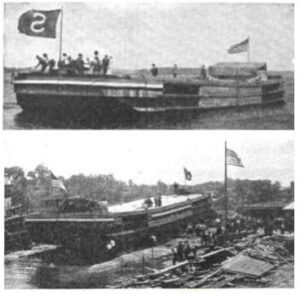
Socony, the first concrete oil tanker, launched in 1918. Below, a second version of the oil barge.
“Eight-inch cast iron pipe lines lead to each compartment and the oil pump is located on a concrete pump room aft,” the journal explained. Steel shortages during World War II would lead to the construction of larger reinforced concrete oil tankers.
July 28, 1924 – Oil Scouts form National Group
The National Oil Scouts Association of America — today the International Oil Scouts Association (IOSA) — filed its charter in Austin, Texas, bringing new standards to an important oilfield profession.
Since the 1860s, oilfield scouts have gathered field intelligence on drilling operations — including often sensitive information about the operator, location, lease, depth of well, formations encountered, logs and other data, which may yield a competitive advantage.
Learn more in Oil Scouts – Oil Patch Detectives.
July 28, 1953 – Final Oilfield Patent for Zero Hour Bomb Company
Manufacturer of oilfield products since 1932, the Zero Hour Bomb Company of Tulsa, Oklahoma, received its last U.S. patent relating to electric timer explosives for fracturing geologic formations. The service company patented its device for positioning blasting cartridges in wells — a “well bridge” that automatically opened, “when the time bomb or weight reached a position at the bottom of the well.”
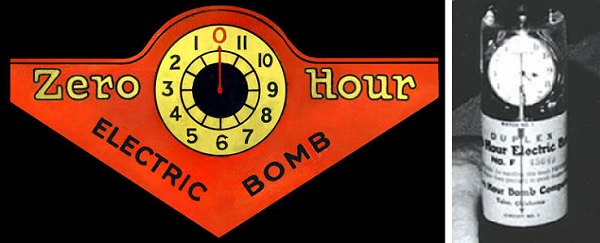
Oilfield service provider Zero Hour Bomb Company was founded in Tulsa, Oklahoma, in 1932. Photos courtesy Zebco.
The downhole apparatus was never built, because company executives already were manufacturing and marketing a new, “cannot backlash” fishing reel invented by Jasper “R.D.” Hull, who they had hired in 1947. Zero Hour Bomb Company changed its name to Zebco in 1956.
Learn more in Zebco Reel Oilfield History.
July 28, 1977 – Trans-Alaska Pipeline delivers Oil to Port of Valdez
The first barrel of oil from the North Slope’s Prudhoe Bay oilfield arrived at the Port of Valdez after an 800-mile journey through the Trans-Alaska Pipeline System. At peak flow in 1988, 11 pumping stations moved 2.1 million barrels of oil a day. The 48-inch-wide pipeline has been recognized as a landmark of engineering (see Trans-Alaska Pipeline History).
July 29, 1918 – Giant Oilfield discovered at Burkburnett, Texas
Less than a year after the “Roaring Ranger” discovered an oilfield to the south, the Fowler No. 1 well at the cotton farming community of Burkburnett, Texas, revealed a new giant field at a depth of 1,734 feet. Within three weeks 56 rigs were drilling near the Fowler Farm Oil Company site along the Red River in North Texas.
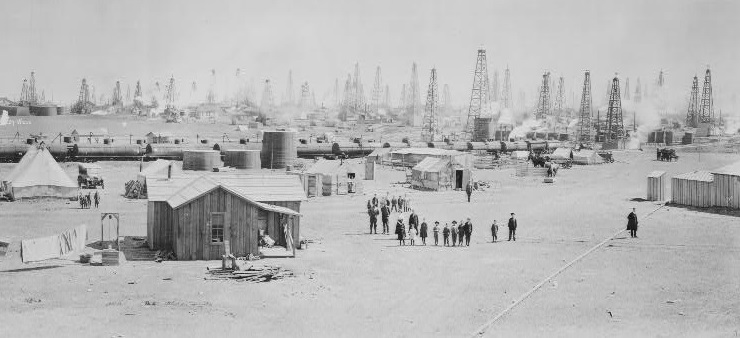
Circa 1919 photo captioned, “Burkburnett, Texas, the World’s Wonder Oil Pool,” showing eight months phenomenal development, viewed from the northwest side, opposite Fowler farm.” A. Newman Photographic Company photo courtesy Library of Congress.
Fowler’s decision to drill a well on his Wichita County farm had been called “Fowler’s Folly” until his oil discovery brought hundreds of oil companies to the county. By January 1919, Burkburnett’s population reached more than 8,000 people — with a line of derricks two-miles long greeting new arrivals.
As the “World’s Wonder Oil Pool” made national headlines, teenager Clark Gable was a 17-year-old roustabout working in Oklahoma. In 1941, Gable and Spencer Tracy would star in Hollywood’s version of Burkburnett oil history, the popular movie “Boom Town.”
Learn more in Boom Town Burkburnett.
July 29, 1957 – Eisenhower limits Oil Imports
As America’s reliance on foreign oil continued to grow — discouraging domestic production — President Dwight D. Eisenhower established a Voluntary Oil Import Program with import quotas by region. The intent was to ensure adequate domestic petroleum in case of a national emergency. Using a presidential proclamation two years later, Eisenhower made the program mandatory. By 1962, oil imports were limited to 12.2 percent of U.S. production. The program continued until suspended by President Richard Nixon in 1973 as domestic oil production reached new highs during the OPEC oil embargo.
July 30, 1942 – U-Boat sunk, found in 2001 by Pipeline Survey
A Navy patrol boat attacked a German U-boat in the Gulf of Mexico soon after the submarine had torpedoed and sunk a U.S. freighter. Despite being depth charged, the U-166 was believed to have escaped — until a natural gas pipeline survey revealed it 59 years later.
The U-166’s identity was not learned until advanced geophysical survey technologies arrived in 2001, the National Oceanic and Atmospheric Administration (NOAA) explained in March 2013. The discovery resulted from an archaeological survey prior to construction of a natural gas pipeline by the British company BP and Shell Offshore Inc.
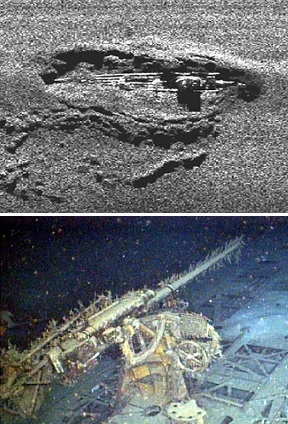
A natural gas pipeline survey revealed the U-166 about 45 miles off the Louisiana coast in 2011.
Remotely operating vehicles (ROVs) and an autonomous side-scan sonar revealed U-166 separated from its last victim, the Robert E. Lee, by less than a mile. As a result of the discovery, BP and Shell altered their proposed pipeline to preserve the site.
Other World War II vessels have been discovered during Gulf of Mexico oil and natural gas surveys, because the petroleum industry is the principle user of advanced underwater technologies for seafloor mapping.
Learn more in Petroleum Survey discovers U-boat.
_______________________
Recommended Reading: The Oil Scouts – Reminiscences of the Night Riders of the Hemlocks (1986); Wildcatters: Texas Independent Oilmen
(1984); Eisenhower: Soldier and President
(1968); The Extraction State, A History of Natural Gas in America (2021); Torpedoes in the Gulf: Galveston and the U-Boats, 1942-1943
(1995). Your Amazon purchase benefits the American Oil & Gas Historical Society. As an Amazon Associate, AOGHS earns a commission from qualifying purchases.
_______________________
The American Oil & Gas Historical Society (AOGHS) preserves U.S. petroleum history. Become an AOGHS annual supporting member and help maintain this energy education website and expand historical research. For more information, contact bawells@aoghs.org. © 2023 Bruce A. Wells. All rights reserved.


